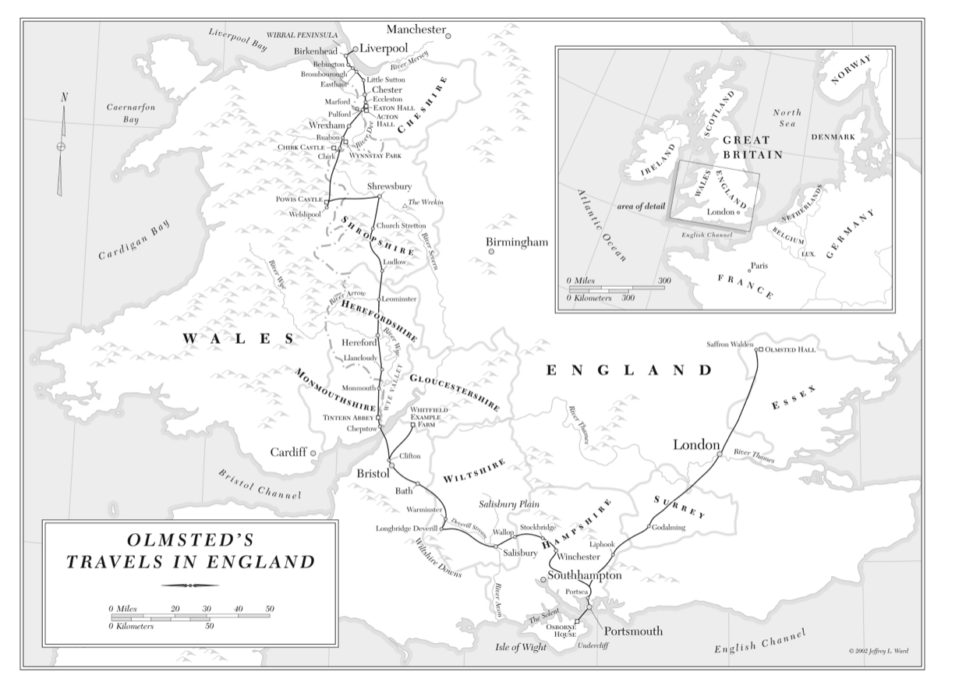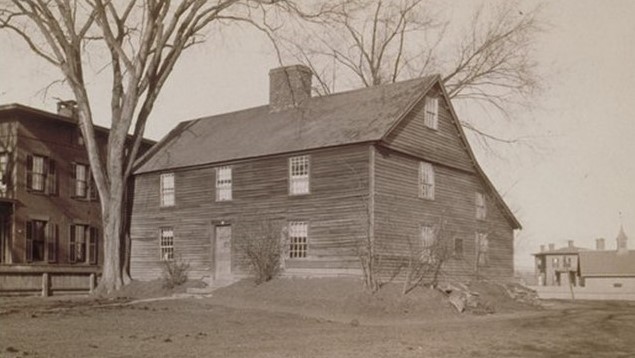
Biographer Justin Martin suggests Frederick Law OImsted is the “most important figure that the average person knows least about.” On the occasion of his 200th birthday, that may be about to change. Dozens of books are being published, exploring aspects of Olmsted’s multi-faceted life and career.
Many are the work of the Library of American Landscape History, which is releasing an Olmsted catalog and a special spring edition of View Magazine, dedicated to the Olmsted legacy. There you can find a new edition of Olmsted’s first book, Walks and Talks of an American Farmer in England, as well as essay collections by Betsy Barlow Rogers, first director of the Central Park Conservancy, and famed landscape architect Laurie Olin. Both are members of the Olmsted 200 Honorary Committee.
Of course, the definitive source for all things Olmsted remains the Papers of Frederick Law Olmsted, the life work of Series Editor Charles Beveridge. In 2020, Beveridge published the 12th and final volume, Frederick Law Olmsted: Plans and Views of Communities and Private Estates. This, paired with Frederick Law Olmsted: Plans and Views of Public Parks, offers an instructive and visually compelling introduction to key projects by Olmsted Sr.
Equally exciting is the release next month by the University of Virginia of a digitized edition of the Olmsted Papers Vols. 1-10 by its Rotunda Imprint.
The Master List of Design Projects by the Olmsted Firm, 1857-1979, remains the best guide to Olmsted Projects. OlmstedOnline, www.olmstedonline.org, provides a one-stop digital portal to Olmsted plans, archival photos, and Library of Congress correspondence.
In 2022, the Library of Congress (LOC) and National Park Service (NPS) have announced programs dedicated to Olmsted. The NPS Historic American Landscapes Challenge for 2022 will be Olmsted Landscapes. The Olmsted firm had nearly 6000 projects in the course of hundred years, providing much content for HALS surveys.
The LOC has also announced a By the People Crowd Sourcing Transcription Project, inviting the public to assist in the transcription of Olmsted firm correspondence. You can read more here.
Olmsted and the National Park Idea
Olmsted’s vision for a system of national parks is the focus of two new and important books
Ethan Carr and Rolf Diamant have partnered on Olmsted and Yosemite, a brief but incisive examination of Olmsted’s 1865 Yosemite report. The authors cogently argue that Olmsted’s critical – now largely forgotten — role in the founding of the national parks was “manipulated to erase reference to an activist government working on behalf of freedom, civil rights, and the remaking of the republic.” Author Dennis Drabelle in turn explores Olmsted’s campaign to save Niagara Falls and his support of national parks in The Power of Scenery. The Wall Street Journal named Drabelle’s book one of its holiday favorites and the reviewer called it “a micro-history that feels big.” These authors will be featured in upcoming video programs and conferences sponsored by NAOP and LOC.
Olmsted & Landscape Design
Architects of an American Landscape, by Hugh Howard examines the friendship and collaboration of architect Henry Hobson Richardson and neighbor Frederick Law Olmsted. The Wall Street Journal review called the book a “readable, intelligently paced dual biography,… the literary equivalent of a rolling, Olmstedian greensward.” You can hear Hugh Howard and others discussing Olmsted, Richardson and Charles Sprague Sargent here.
Rizzoli has just released a new and updated edition of Charles Beveridge’s classic work on Olmsted, Designing the American Landscape. This volume offers crisp commentary and exquisite photos that illustrate the diverse array of landscape designs that constitute Olmsted’s enduring legacy.
What existed before Central Park? That’s the focus of Central Park historian emerita Sara Cedar Miller whose book, Before Central Park, promises an authoritative account of the history of the Park including stories of Indigenous hunters, enslaved people and enslavers, American patriots and British loyalists, the Black landowners of Seneca Village, Irish pig farmers, tavern owners, Catholic sisters, and Jewish protesters. New York Times columnist Brent Staples notes in a recent column that “[t]he Seneca Village story is often recounted through the lens of tragedy and woe, but … Miller relates a more nuanced tale … In this telling, land ownership in the village is cast as an engine of empowerment, and even enrichment for African Americans who exploited the real estate wave and cashed out at the right moment.” The book also covers the early years of the park, from 1840s to 1853.
Olmsted and Public Health
Olmsted’s work to advance public health receives attention in two recent books.
Clean: The New Science of Skin by Atlantic writer James Hamblin dedicates a substantial section of the final chapter to Olmsted whom Hamblin calls “an idealistic millennial spirit living in the 1840s.” Hamblin sees Olmsted’s park making as “shaping the appearance and culture of the nation, bringing it together in its time of deepest division.”
Author Sara Jensen Carr credits Olmsted with “coalescing health, social justice and ecology in his works” in her book The Topography of Wellness: How Health and Disease Shaped the American Urban Landscape (University of Virginia Press).
Frederick Law Olmsted Jr.
Long in the shadow of his father, Frederick Law Olmsted Jr., receives his first biography with Beauty, Efficiency, and Economy: A Life of Frederick Law Olmsted Jr. by author Elizabeth Hope Cushing. Cushing argues convincingly that Olmsted’s famous father has for too long obscured Junior’s major contributions to the field.
In May of 2022, the White House Historical Association will release another examination of Junior. This one will be dedicated to his 1903 Master Plan for the White House grounds.
Olmsted Landscapes Across the Country
Given the expanse of Olmsted firm projects, it’s no surprise that many new books look at the Olmsted firms’ national and local contributions.
The Cultural Landscape Foundation, a founding partner of Olmsted 200, will soon release The Olmsted Legacy. This book explores 200 Olmsted landscapes. Readers will find contemporary and historical photography as well as descriptions of each space.
The US Capitol Historical Society has issued a 2022 Calendar featuring arts, photography and historical notations about Frederick Law Olmsted and the Capitol Grounds.
In the Midwest, Olmsted’s influence in Milwaukee is outlined in the following…
The Milwaukee River Greenway written and collected by Eddee Daniel. This book includes a chapter by Virginia Small entitled “Frederick Law Olmsted’s Influence: Riverside Park and the Greenway Concept.”
Two photographers offer perspectives on Olmsted’s work in World’s End: A Panoramic Tour of Olmsted’s Masterpiece by Mark Roessler and Olmsted Trees by Stanley Greenberg.
Other illuminating regional discussions include:
Atlanta’s Olmsted Linear Park by NAOP board member Spencer Tunnell and Jennifer Richardson (Arcadia Press, 2022)
Forest Park: Portland’s Natural Sanctuary by Marcy Cottrell Houle (Oregon State University Press for pre-order) and…
A Generous Nature: Lives Transformed by Oregon (Corvallis: Oregon State University Press, 2019)
Immersion: Living and Learning in an Olmsted Garden by Nola Anderson (Damiani, 2021)
Unconscious Influence: Olmsted’s Hartford by Dr. Don Poland
Olmsted for Children
Later this spring, Penguin will release a new book for children by Elizabeth Partridge: Parks for the People: How Frederick Law Olmsted Designed America
Miscellany
One Olmsted family member has written a fictional novel based off the family: Landscape of a Marriage
Another family member has produced a film.
Still Can’t Get Enough?
Audible will offer a new three-hour course—The Enduring Genius of Frederick Law Olmsted by Dr. Adam Rome, Professor of Environment and Sustainability, University at Buffalo College of Arts and Sciences— on April 21. This course explores key questions that Olmsted considered both before and after he dedicated his life to landscape architecture.
Several books are already available on Audible including:
The Cotton Kingdom, narrated by John Lescault
A Journey Through Texas or A Saddle Trip on the Southwestern Frontier, narrated by Troy Davis
Genius of Place, narrated by Richard Ferrone











